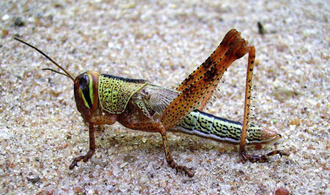Red locusts reveal their colour code
Written by Modified on the
Single locusts are harmless, but in groups, they can devastate crops. From one developmental stage to another, locusts undergo a certain number of biological and physiological changes, and also change their behaviour and colour. For instance, young red locusts (larvae) are green when solitary, but turn orange to yellow with black spots once gregarious. This change is gradual, with several intermediate stages between the two extremes. In Madagascar, CIRAD researchers have shown that the variation in the colour of red locusts could bean early indicator of gregarization, and accurately revealed the colours that locusts gradually take on, depending on their density per square metre (m2). On the island, red locusts (Nomadacris septemfasciata ) are a threat, particularly to the country's rice growing zones. Spreading insecticides, and sometimes even bio insecticides, is the main control method. Understanding the mechanism where by locusts change from one phase to another and identifying the earliest stages that trigger the phenomen on would make it possible to adopt early, targeted control strategies.
A blackspot on the femur: the very first sign of gregarization
For the study, more than 1100 red locust larvae were collected in southwesternMadagascar, in zones with densities of between fewer than one locust/m2 and several hundred locusts/m2. For each individual, the colour of the head, eyes and bodywas studied. In this way, each population density was characterized by aspecific colour range. The researchers revealed the very first sign of gregarization, as of ten locusts/m2: a black spot on the femur of the backlegs. As of 30 locusts/m2, the head turns reddish-orange and the first thoracic segment turns yellow, with a slightly black stripe down the back. As of 70 locusts/m2, the rear of the head and the eyes begin to turn black. With more than 100 locusts/m2, the body turns bright orange, the yellow colour of the first thoracic segment increases and the black patches become darker.
Towards fine-tuned prevention
The colour code defined reflects red locust density and the gradual evolution from the solitary to the gregarious phase. This colour typology for locust populations -based on simple, un ambiguous criteria - will help make field data more reliable. For instance, the national locust control centre in Madagascar cannow follow the change from one phase to another more closely, hence monitor the threat posed by red locust populations and thus improve its prevention an dearly control strategy, centring on limited areas of the country.
This work was part of a research project on red locusts CIRAD was requested to carry out by the Centre national malgache de développement rural (FOFIFA), with African Development Bank (ADB) funding. It was done in collaboration with the national locust control centre in Madagascar (CNLA) and the University of Tulear.


